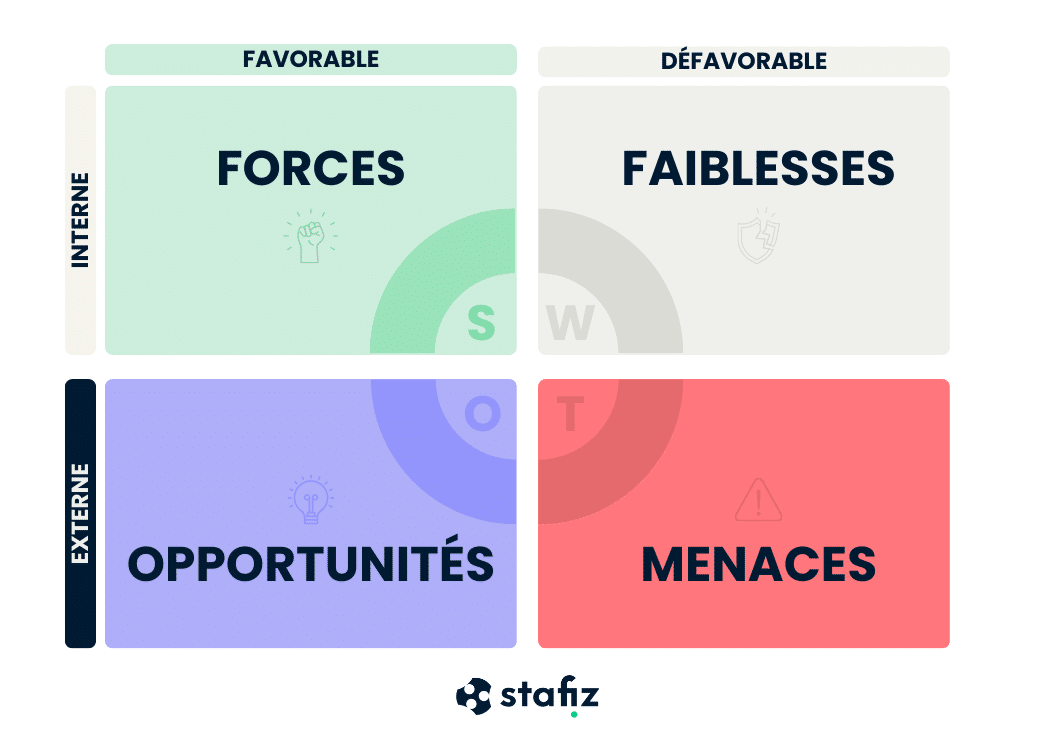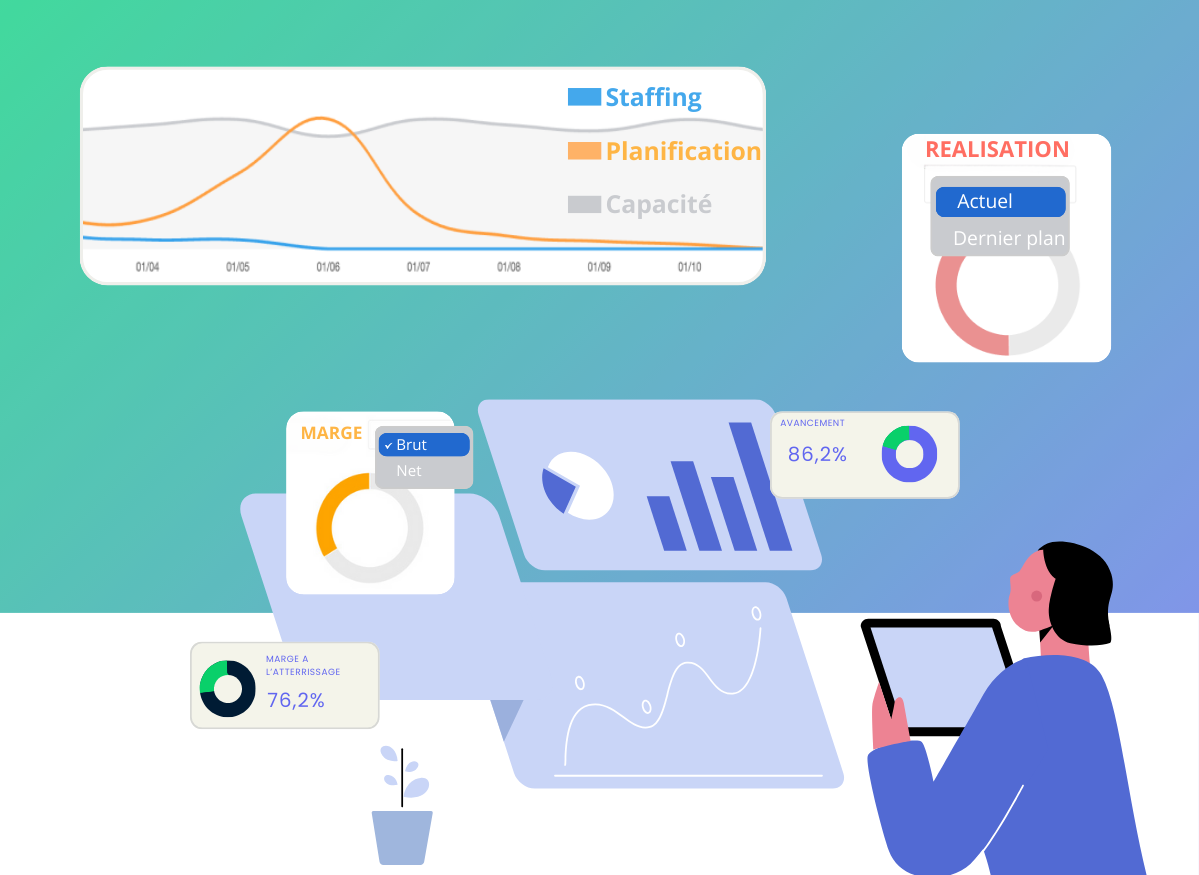How To Conduct a Gap Analysis in Project Management

Why do some projects fail despite careful planning? Why do others slip up in terms of budget or deadlines?
The answer often lies in poor or no gap analysis at all.
Yet, this stage is essential at both project and company level. This essential practice enables us to measure the differences between plan and reality, and make any necessary corrections.
In this article, we will mainly deal with gap analysis in project management, although we will sometimes cover a more global point of view. Our goal is to give you all the keys to improve the preparation of your projects, in order to anticipate, react and optimize your processes.
What is Gap Analysis in Project Management?
Gap analysis: definition
- A discrepancy between planning and the observed state
Variance analysis consists of comparing the current state with what had been planned.
This implies having planned objectives to be achieved, whether financial, temporal or human.
- Application at different levels
While this article focuses mainly on gap analysis in the context of a project, it is actually about the management of a company as a whole.
Indeed, variance analysis is one of the main steps in management control. It is essential for accurate project monitoring, to identify problems and areas for improvement.
The 4 main types of gaps in project management
We will focus on the 4 main types of variances in project management:
- budget variances;
- time differences;
- perimeter deviations;
- performance gaps.
Budget variances
Also known as cost variances, this is the difference between the actual expenses and the initially defined budget.
Time gaps
Time gaps take into account the discrepancy between the time that was needed to develop the project and the time that had been anticipated.
Perimeter differences
The differences in this category can be varied and concern several aspects.
Unplanned features, a change in technology, a higher number of contents... These variables will generate discrepancies between the scope initially planned and the one to be considered from now on.
Performance gaps
Performance gaps take into account the difference between actual and expected performance.
This can concern various criteria such as the quality delivered, the performance of a feature, a campaign, or the productivity of the teams.
Other types of possible deviations
There are other types of gaps, such as:
- Labor gaps, which take into account the difference between the number of employees needed and the employees actually active on the project.
- market discrepancies or product discrepancies, which relate to the difference between actual and anticipated sales;
- profit gaps, which highlight the discrepancy between the profit made and the budgeted profit.
Why do a gap analysis?
Identify and anticipate problems
Ensuring sound financial management
One of the main motivations for gap analysis is to identify problems. The financial aspect is usually considered first.
This exercise is a way of assessing the financial health of a project or a company.
Enable a reliable inventory of fixtures
As such, variance analysis is used to examine the current state to verify that everything is going according to plan.
This allows you to base your decisions on real facts rather than mere assumptions.
Compensate and rectify the consequences of deviations
Analyze to correct
Gap analysis is only relevant if it is completed by corrective action. In reality, it is only the first step in a long process.
It gives you a clear view of the points that need to be corrected. Your role is then to find ways to close these gaps, which requires a thoughtful strategy in place.
Use budget variance analysis tools
Note that there are powerful tools to help you identify and correct discrepancies.
Designed specifically for project management, they incorporate a maximum of automation to facilitate project and business management.
Stafiz is one of them and offers advanced features to maintain the financial health of your projects.
Triggering alerts in the event of deviations or creating scenarios are valuable aids in budget monitoring. This remains essential for good project management.
Identify opportunities for improvement
Optimize and drive growth
Gap analysis is not only intended to be corrective. This approach can also help identify opportunities for optimization or even growth.
Indeed, gap analysis makes it possible to draw up an inventory of the situation, the project or the company, by providing valuable information. These then serve as material to guide choices, thus improving decision-making.
The Role of Gap Analysis in the Management of resource planning
In addition to the financial aspect, resource management also benefits greatly from gap analysis as well.
By analysing the specific needs of certain skills or areas, desires and availability, it is possible to make a clear inventory of the resources available versus those needed.
As this balance can change over time, gap analysis ensures that the company or project has the right resources at the right time. Gap analysis makes resource allocation much easier.
Other benefits of a gap analysis
Evolving the overall strategy
Gap analysis also has many benefits for the entire company, not just at the project level.
In fact, it identifies gaps and highlights the need to optimize the overall strategy.
Help prioritize
In addition, gap analysis helps prioritize because it helps identify the most relevant opportunities in a project portfolio.
Indeed, it is in the company's best interest to focus on projects where it has the necessary resources or competitive advantages.
How to identify gaps in project management?
Define an action plan
Identify the elements that motivate this research
Before you rush into an in-depth gap study and analysis, take the time to ask yourself some questions. Indeed, it is necessary to establish a meticulous preparation as well as a precise action plan. For example, ask yourself:
- What drives you to look for deviations?
- What are your first guesses? What are you looking to discover?
- How will you accurately measure the deviations?
Finding the root of the problem
Once the problem has been identified, the next step is to look for its root: why is this gap observed? This will require some investigation.
Visualize the ideal situation
The next step in the action plan will not be to find a solution immediately, but to draw the contours of an ideal situation to which you aspire.
Projections and scenarios are therefore formidable tools for this task.
Gather information
Consider any data source
You will look for specific information to support your assumptions.
Identify any element that could have an impact on costs (market changes, legal, technological, consumer habits, costs of raw materials, human resources) or on time (reductions in staff, motivation, modification of equipment).
External and internal factors
Many factors, both internal and external, can generate discrepancies.
Make sure to collect as much information as possible, from your service providers, suppliers, customers. Customer and sales service, directly with consumers, can be an interesting source of information.
Historical history and analysis of past variances are also relevant.
What are the best tools for budget variance analysis?
An all-in-one tool
As mentioned earlier, there are powerful tools to help you identify and analyze gaps.
Stafiz offers many features such as the creation of provisional budgets or the help in the creation of complete dashboards .
These allow you to monitor KPIs in real time in order to detect any possible discrepancies.
Recognized tools and frameworks
Other tools are commonly used for gap analysis because they allow for comprehensive introspection. These are recognized frameworks.
- The SWOT (Strengths, Weaknesses, Opportunities, Threats) which allows you to identify strengths, weaknesses, opportunities and threats.

- The 7S method (Structure, System, Style, Staff, Skill, Strategy, Shared Values) which helps to clarify the way in which each component is articulated:
- Structure: describes the distribution of activities within the company or project (hierarchy, role)
- System: describes the processes and procedures used (computer systems, tools, workflows)
- Style: How leaders influence the organization
- Staff: the number of staff and the way they are recruited and trained
- Skill: abilities and talents
- Strategy: how the company plans to achieve its long-term goals (strategic decisions)
- Shared values: culture and values
How do you analyze project variances?
What recurring factors can lead to cost variances?
Regardless of their nature, deviations must be analyzed to prevent them from recurring.
The analysis of the gaps therefore includes a research phase because it is necessary to identify their origin. Here are a few tips.
An erroneous estimate
A wrong estimate caused by unreliable data, or an overly ambitious vision can lead to discrepancies.
When you make a budget, consider all the factors (possible increase in raw materials, labor).
An uncontrolled allocation of resources can generate large discrepancies.
A change of scope
Adding new features, changing the project context , or adding unanticipated tasks can cause discrepancies.
Risk management needs to be reviewed
Sloppy risk management, or worse, forgotten risk management, can lead to serious deviations.
For example, an unanticipated budget margin can have significant consequences.
An organizational problem
Internal conflicts or miscommunication can affect productivity and cause time or budget variances.
External causes
Other external causes related to a political, legal, or supplier-related environment can also cause discrepancies.
How do you know if a gap is favorable or unfavorable?
A gap is rarely favourable.
It is true that its consequences can have positive effects, such as saving money or time. Nevertheless, neither is really enviable because they are a sign of a bad estimate.
Because of this, they may question your project management skills.
In another case, it may be perceived as a loss of quality if the time consumed is lower than estimated.
In any case, it is advisable to write a production report to take stock of the situation and serve as a basis for preparation for subsequent projects.
What corrective actions should be put in place?
The gap analysis should alert you and encourage you to adapt your strategy.
The strategy to be adopted will depend on the differences observed and their intrinsic causes. However, here are some avenues to explore to correct and avoid discrepancies:
- improve risk analysis ;
- improve estimates;
- track accurately with project management tools (budget reviews, time spent);
- optimize internal processes;
- Improve team training.
Gap analysis is an essential tool in project management. It allows you to effectively monitor progress, identify anomalies and rectify them.
Beyond identification, understanding the source of deviations is crucial to applying appropriate corrective actions. This approach, although essential at the project level, benefits from being extended to the scale of the company's portfolios or programs. It then becomes a strategic lever to guarantee its performance and support its growth.
Program Management: Best Practices
Questions:
- Define the initial budget: Accurately document financial goals, resource requirements, and create different scenarios to anticipate unforeseen events.
- Collect data in real-time: Aggregate actual spend and results observed during the project.
- Compare data: Analyze the differences between the planned budget, actuals, and forecast to identify and even anticipate variances.
- Identify the causes of deviations: Find the origin of deviations (estimation errors, unforeseen changes, external factors, etc.).
- Develop a corrective plan: Propose actions to reduce gaps and avoid recurrence in future projects.
- Track and adjust regularly: Constantly monitor for deviations as soon as they appear. To be on the safe side, opt for a tool like Stafiz, which alerts you as soon as a deviation is identified in the forecast.
At an advanced stage, a budget revision may be necessary.
A large part of the effort is mobilized from the planning of the budget.
Improve your forecasting based on historical data so you can realistically anticipate risks. Plan for a safety margin!
Regular monitoring is imperative to control your budget. Use software like Stafiz, which offers real-time predictive monitoring to stay proactive in the event of unforeseen events.
Training your teams in budget management is a great way to limit gaps related to human error. Therefore, also make sure to set up effective communication channels to limit misunderstandings.




